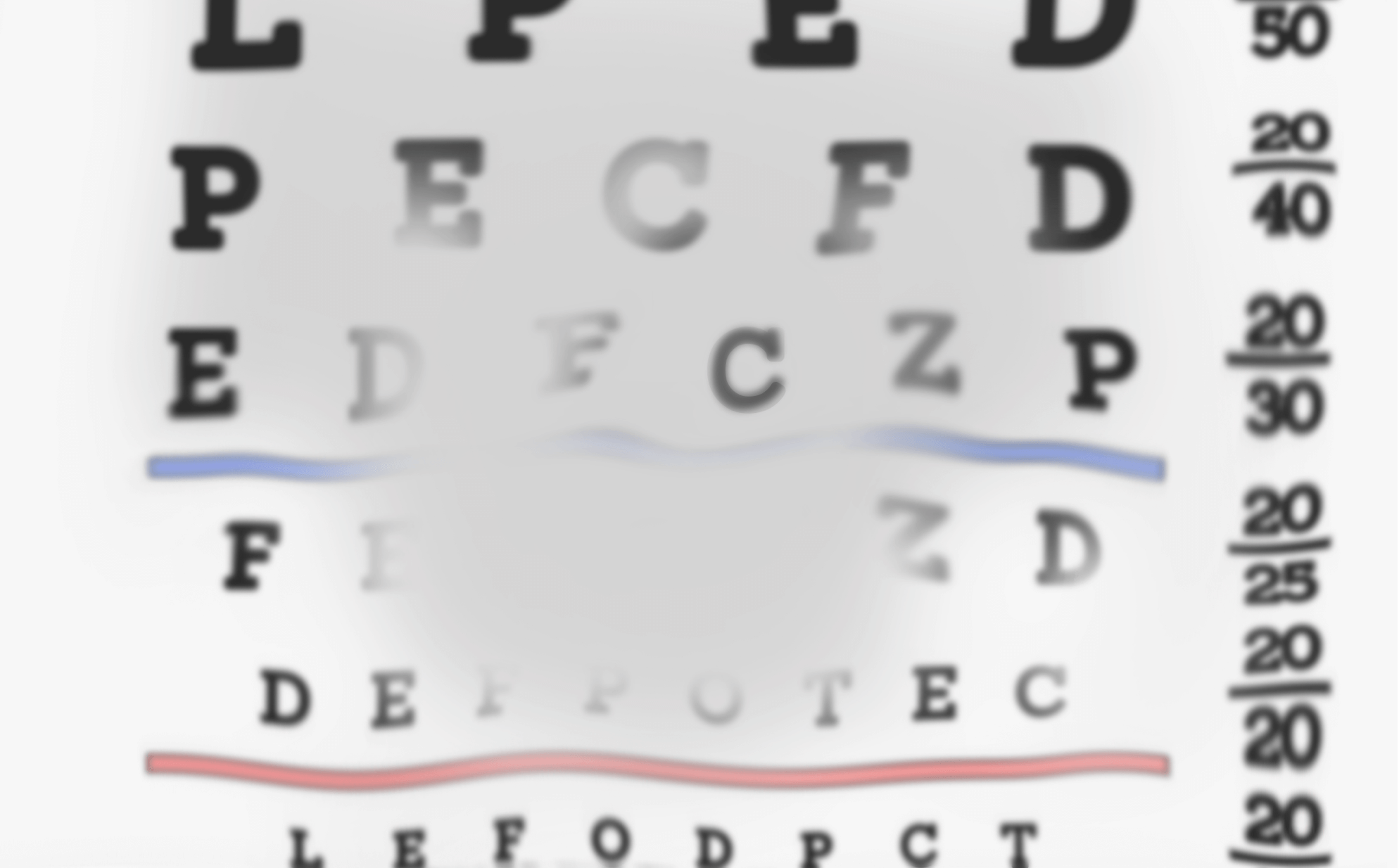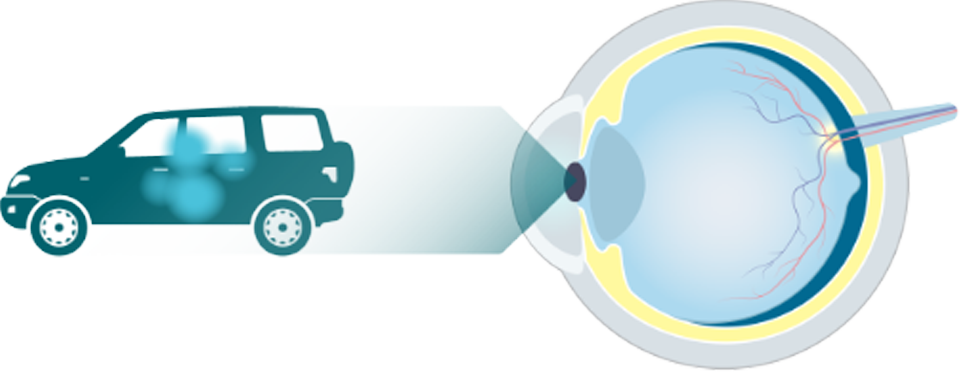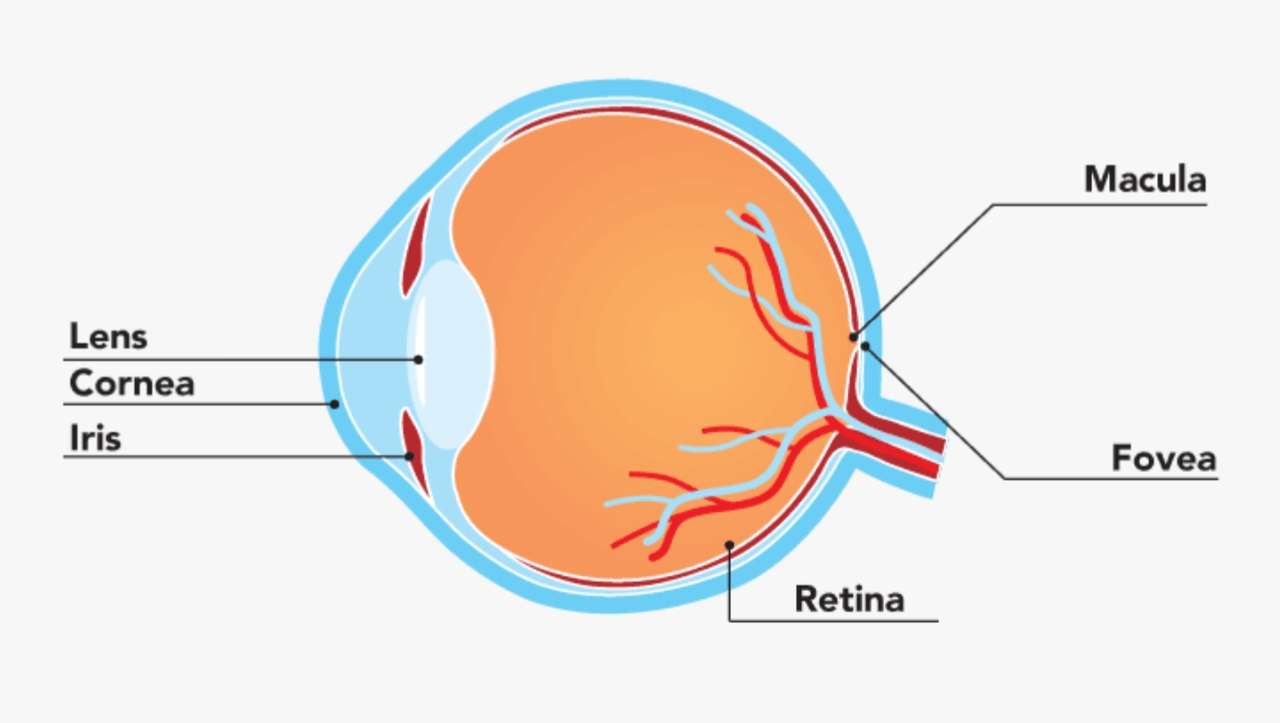Geographic Atrophy (GA) is a severe form of age-related macular degeneration (AMD) that leads to vision loss. GA affects the central retina, causing progressive blindness.
Geographic Atrophy is a chronic, progressive eye disease that predominantly affects older adults. It specifically targets the macula, the central part of the retina responsible for sharp, detailed vision. GA results from the gradual degeneration of retinal cells, leading to patches of vision loss.
Risk factors include aging, genetics, and lifestyle choices like smoking. Early detection and management are crucial to slowing its progression. Currently, there is no cure, but ongoing research aims to find effective treatments. Regular eye examinations can help in early diagnosis and better management of this debilitating condition.

Credit: eyesonga.com
What is GA Eye Disease?
GA Eye Disease, also known as Geographic Atrophy, is a progressive eye condition. This disease affects the retina, causing vision loss over time. Understanding GA Eye Disease is crucial for early diagnosis and treatment. Let’s explore what GA Eye Disease is and its various aspects.
GA Eye Disease is a severe form of age-related macular degeneration (AMD). It leads to the gradual deterioration of the macula, the central part of the retina. The macula is responsible for sharp, central vision. Damage to this area can result in significant vision impairment.
Several factors contribute to the development of GA Eye Disease. These include:
- Age: People over 50 are at higher risk.
- Genetics: Family history plays a role.
- Smoking: Increases the risk significantly.
- Poor diet: Lack of nutrients can affect eye health.
Early symptoms might be subtle, making it hard to detect. Common signs include:
- Blurred vision
- Difficulty recognizing faces
- Dark or empty areas in the center of vision
- Colors appearing less vibrant
Doctors use various methods to diagnose GA Eye Disease:
| Method | Description |
|---|---|
| Optical Coherence Tomography (OCT) | A non-invasive imaging test to view the retina. |
| Fundus Photography | Captures detailed images of the retina. |
| Visual Acuity Test | Measures the clarity of your vision. |
Treatment Options
Currently, no cure exists for GA Eye Disease. Treatments focus on slowing its progression:
- Vitamin Supplements: Helps maintain eye health.
- Anti-VEGF Therapy: Reduces blood vessel growth.
- Laser Therapy: Targets damaged areas of the retina.
Regular eye check-ups can help detect GA Eye Disease early. Early detection and treatment can slow vision loss. Take care of your eyes and maintain a healthy lifestyle to reduce risk.
Natural Supplements for Eye Health
Taking care of the eyes is very important, especially if someone has Thyroid Eye Disease. There are natural supplements that can help keep the eyes healthy. One such supplement is iGenics.
iGenics is a natural eye supplement for anyone who wants to protect their eyes from age-related vision decline. It’s an easy, capsule-based dietary supplement that contains 12 simple natural ingredients. With 100% organic extracts, it clinically addresses the root cause of vision decline, leading to clear vision and boosted confidence. This solution, enriched with ancient plant extracts, also benefits memory, immune health, and inflammation response.
iGenics capsules, a potent formula, come in monthly supply bottles for easy use. Regular dosing renews eye cells, improving the retina and lens clarity. Manufactured in the USA under FDA-approved and GMP-certified guidelines, the formula is free from chemicals and additives, prioritizing safe results for consumers.
Symptoms Of Ga Eye Disease
GA Eye Disease, also known as Geographic Atrophy, is a progressive eye condition that affects the macula. This disease leads to the gradual loss of vision. Recognizing the symptoms early can help manage the condition better. Below, we explore the main symptoms of GA Eye Disease.
Gradual Vision Loss
One of the primary symptoms of GA Eye Disease is gradual vision loss. This symptom progresses slowly and may not be noticeable initially. Over time, it becomes more evident and can severely impact daily activities. Here are some common signs:
- Difficulty reading small print
- Challenges in recognizing faces
- Need for brighter light when reading or doing close work
Gradual vision loss can be measured through regular eye exams. Ophthalmologists often use various tests to monitor the progression of the disease:
| Test | Description |
|---|---|
| Visual Acuity Test | Measures the clarity of vision |
| Amsler Grid Test | Detects vision distortions |
| Optical Coherence Tomography (OCT) | Provides detailed images of the retina |
Regular eye check-ups are crucial for early detection and management of gradual vision loss in GA Eye Disease.
Blind Spot
Another significant symptom of GA Eye Disease is the development of a blind spot. This blind spot usually appears in the central vision. It can interfere with activities that require focused vision. Here are some indicators:
- Difficulty seeing objects directly in front
- Missing letters or words while reading
- Struggling to see traffic lights while driving
The blind spot can vary in size and location. Its progression can be monitored through specific tests:
| Test | Description |
|---|---|
| Fundus Photography | Captures detailed images of the retina |
| Visual Field Test | Assesses the scope of vision |
Early detection of a blind spot can help in adapting daily activities and improving quality of life.
Distorted Vision
Distorted vision is another common symptom of GA Eye Disease. This symptom makes straight lines appear wavy or bent. It can significantly affect tasks that require precision. Key signs include:
- Difficulty reading text
- Issues with driving, especially at night
- Challenges in distinguishing shapes
Ophthalmologists use specific tools to detect and measure distorted vision:
| Test | Description |
|---|---|
| Amsler Grid Test | Identifies distortions in vision |
| OCT Scan | Provides detailed retinal images |
Monitoring distorted vision is essential for managing GA Eye Disease effectively. Regular eye exams help detect changes early and adapt to them.
Causes Of Ga Eye Disease
Geographic Atrophy (GA) is a severe form of age-related macular degeneration (AMD). This eye disease affects the central part of the retina. Understanding the causes of GA eye disease can help in its prevention and management. The main causes include aging, genetics, smoking, and obesity.
Aging
Aging is a significant cause of GA eye disease. As people get older, their eyes undergo various changes. These changes can lead to the development of GA. Some of the common changes include:
- Thinning of the retina: This makes the retina more vulnerable to damage.
- Accumulation of waste products: These products build up in the retina, causing damage over time.
- Reduced blood flow: This can deprive the retina of essential nutrients and oxygen.
Aging affects the eye’s ability to repair itself. This increases the risk of developing GA. Regular eye check-ups can help detect these changes early. Early detection is key to managing and slowing the progression of GA.
Genetics
Genetics plays a crucial role in the development of GA eye disease. Certain genes increase the risk of developing this condition. These genes can be inherited from parents. Some key genetic factors include:
- Complement factor H (CFH): This gene regulates inflammation. Variations in CFH can lead to excessive inflammation, damaging the retina.
- ARMS2/HTRA1: These genes are linked to the maintenance of the retina. Mutations in these genes can cause retinal degeneration.
Family history is an important indicator of genetic risk. If a close relative has GA, the risk of developing it increases. Genetic testing can help identify these risks early. Knowing your genetic risk can guide lifestyle and preventive measures.
Smoking
Smoking is a significant risk factor for GA eye disease. The harmful chemicals in cigarettes damage the eyes. Smoking leads to:
- Reduced blood flow: This deprives the retina of essential nutrients and oxygen.
- Oxidative stress: This damages retinal cells, leading to their degeneration.
- Inflammation: This causes further damage to the retina.
Quitting smoking can significantly reduce the risk of developing GA. Even long-term smokers can benefit from quitting. The eyes start to heal once smoking stops. Avoiding secondhand smoke is also important. Exposure to secondhand smoke can also increase the risk of GA.
Obesity
Obesity is another risk factor for GA eye disease. Excess body weight can lead to several health issues that affect the eyes. These include:
- High blood pressure: This can reduce blood flow to the retina.
- Diabetes: This increases the risk of diabetic retinopathy, which can lead to GA.
- Inflammation: Excess fat tissues can cause chronic inflammation, damaging the retina.
Maintaining a healthy weight is crucial for eye health. A balanced diet and regular exercise can help achieve this. Monitoring and managing underlying health conditions is also important. This can significantly reduce the risk of developing GA.
Diagnosis Of Ga Eye Disease
Geographic Atrophy (GA) Eye Disease is a severe form of age-related macular degeneration. It leads to a gradual loss of vision. Diagnosing GA Eye Disease early is crucial for managing its progression. The diagnosis involves several specialized tests and examinations to assess the extent of retinal damage.
Retinal Exam
A retinal exam is the first step in diagnosing GA Eye Disease. During this exam, an eye specialist uses a device called an ophthalmoscope. This device shines a bright light into the eye, allowing the doctor to see the back of the eye clearly.
The doctor checks for signs of damage in the retina. These signs include drusen, which are yellow deposits under the retina, and areas of thinning or loss of retinal cells. The exam is non-invasive and usually takes only a few minutes.
Some key points observed during a retinal exam include:
- Presence of drusen
- Thinning of retinal layers
- Changes in retinal pigmentation
- Atrophy areas in the macula
Below is a table summarizing the signs observed:
| Signs | Description |
|---|---|
| Drusen | Yellow deposits under the retina |
| Thinning | Loss of retinal layers |
| Pigmentation | Changes in color of the retina |
| Atrophy | Areas of cell loss in the macula |
Fluorescein Angiography
Fluorescein angiography is another important test for diagnosing GA Eye Disease. This test involves injecting a fluorescent dye into a vein, usually in the arm. The dye travels through the bloodstream to the blood vessels in the eye.
A special camera takes pictures of the retina as the dye passes through its blood vessels. These images help the doctor see how blood is flowing in the retina and identify any abnormalities.
Key steps in fluorescein angiography include:
- Injecting the fluorescent dye
- Taking a series of photographs
- Analyzing the images for blockages or leaks in blood vessels
- Identifying areas of atrophy
This test helps to detect areas of poor blood flow and identify regions of the retina that are not receiving enough nutrients.
Some common findings from fluorescein angiography include:
- Blocked blood vessels
- Leaky blood vessels
- Areas of retinal atrophy
- Abnormal blood vessel growth
Optical Coherence Tomography
Optical Coherence Tomography (OCT) is a non-invasive imaging test. It uses light waves to take cross-sectional pictures of the retina. This test is very effective in diagnosing GA Eye Disease.
OCT provides detailed images of the retina’s layers. It helps to detect early signs of retinal damage and monitor the progression of GA.
Key features of OCT include:
- High-resolution images
- Non-invasive procedure
- Quick and painless
- Detailed cross-sections of the retina
During an OCT scan, the patient places their head on a support to keep it still. The machine then scans the eye, taking multiple images in seconds. These images are analyzed by the doctor to look for signs of GA.
Common findings on OCT scans include:
- Thinning of retinal layers
- Disruption of retinal structure
- Accumulation of drusen
- Areas of geographic atrophy
OCT is a powerful tool for monitoring changes over time and assessing the effectiveness of treatments.
Treatment Of Ga Eye Disease
Geographic Atrophy (GA) is a severe form of age-related macular degeneration (AMD) that leads to gradual vision loss. While there is no cure for GA, various treatments and aids can help manage the symptoms and improve the quality of life for those affected. This section will discuss the available treatment options for GA Eye Disease.
No Cure
Currently, there is no cure for GA Eye Disease. The progressive nature of GA makes it challenging to halt or reverse the condition. Despite extensive research, scientists have yet to find a way to restore the damaged retinal cells. Here are some key points to consider:
- Progressive Nature: GA worsens over time, leading to significant vision loss.
- Research Efforts: Ongoing studies aim to find a cure or better management options.
- Patient Support: Support groups and counseling can help patients cope with the diagnosis.
Though there is no cure, managing symptoms and slowing progression is possible through various treatments. The following sections will explore these options in detail.
Prescription Medications
Prescription medications play a crucial role in managing GA Eye Disease. While they can’t cure GA, they can help slow its progression and alleviate symptoms. Here are some commonly prescribed medications:
- Anti-VEGF Injections: These injections help reduce abnormal blood vessel growth and leakage in the retina.
- AREDS Formulations: These supplements contain high doses of vitamins and minerals that can slow down the progression of AMD.
- Anti-inflammatory Drugs: These medications can help reduce inflammation in the retina.
It’s essential to follow the prescribed treatment plan and attend regular check-ups with your eye doctor. Consistent monitoring and timely intervention can make a significant difference in managing GA.
Supplements
Supplements can be beneficial for individuals with GA Eye Disease. They provide essential nutrients that support eye health and may slow disease progression. The Age-Related Eye Disease Study (AREDS) has identified key supplements that are effective:
| Supplement | Benefits |
|---|---|
| Vitamin C | Protects retinal cells from oxidative damage |
| Vitamin E | Reduces the risk of progression in intermediate and advanced AMD |
| Zinc | Supports overall eye health |
| Copper | Prevents copper deficiency caused by high doses of zinc |
| Lutein & Zeaxanthin | May improve macular pigment density |
Consult your eye doctor before starting any supplements to ensure they are appropriate for your condition.
Low Vision Aids
Low vision aids can significantly improve the quality of life for people with GA Eye Disease. These devices help maximize the remaining vision and make daily activities easier. Here are some popular low vision aids:
- Magnifiers: Handheld or stand magnifiers can enlarge text and objects.
- Electronic Reading Aids: Devices like e-readers and tablets offer adjustable text sizes and contrast.
- Text-to-Speech Devices: These gadgets convert printed text into spoken words.
- Adaptive Lighting: Good lighting can reduce glare and improve visibility.
Using low vision aids can enhance independence and make everyday tasks more manageable. Discuss with a low vision specialist to find the most suitable devices for your needs.

Credit: eyesonga.com
Prevention Of Ga Eye Disease
Geographic Atrophy (GA) Eye Disease, a form of advanced macular degeneration, gradually deteriorates central vision. Preventing GA Eye Disease is crucial for maintaining eye health and quality of life. Below are some effective prevention methods that can help reduce the risk of developing this eye condition.
Quit Smoking
Smoking significantly increases the risk of developing GA Eye Disease. Research shows that smokers are up to four times more likely to develop macular degeneration compared to non-smokers. Quitting smoking can greatly reduce this risk.
Here are some tips to help you quit smoking:
- Set a quit date and stick to it.
- Seek support from family and friends.
- Use nicotine replacement therapies like patches or gum.
- Consider prescription medications to reduce cravings.
- Join a support group for additional encouragement.
Benefits of quitting smoking include:
| Benefit | Details |
|---|---|
| Improved Vision | Reduces the risk of GA Eye Disease and other eye conditions. |
| Better Overall Health | Decreases the risk of heart disease, stroke, and lung cancer. |
| Enhanced Quality of Life | Improves breathing, energy levels, and general well-being. |
Healthy Diet
A healthy diet rich in antioxidants, vitamins, and minerals can help prevent GA Eye Disease. Nutrients like Vitamin C, Vitamin E, Zinc, and Omega-3 fatty acids are vital for eye health.
Include the following foods in your diet:
- Leafy greens like spinach and kale.
- Fatty fish such as salmon and mackerel.
- Nuts and seeds, particularly almonds and flaxseeds.
- Fruits like oranges, berries, and kiwi.
- Whole grains and legumes.
Sample meal plan for eye health:
| Meal | Food |
|---|---|
| Breakfast | Oatmeal with berries and a glass of orange juice. |
| Lunch | Grilled salmon salad with mixed greens and avocado. |
| Dinner | Quinoa bowl with roasted vegetables and chickpeas. |
| Snacks | Almonds, carrot sticks, and hummus. |
Regular Exercise
Regular exercise is essential for preventing GA Eye Disease. Physical activity improves blood circulation, which helps maintain healthy eyes by ensuring they receive adequate oxygen and nutrients.
Benefits of regular exercise include:
- Improved blood flow to the eyes.
- Reduced risk of high blood pressure and diabetes.
- Enhanced overall physical and mental well-being.
Suggested exercises for eye health:
- Cardio Workouts: Walking, jogging, cycling, and swimming.
- Strength Training: Weightlifting, resistance band exercises.
- Flexibility Exercises: Yoga, Pilates, stretching routines.
Exercise routine example:
| Day | Activity |
|---|---|
| Monday | 30-minute walk and 15-minute yoga session. |
| Wednesday | 30-minute cycling and 20-minute strength training. |
| Friday | 30-minute jog and 10-minute stretching routine. |
| Sunday | 30-minute swim and 20-minute Pilates session. |
Living With Ga Eye Disease
Living with GA Eye Disease, also known as Geographic Atrophy, can be challenging. This condition affects the retina and leads to progressive vision loss. Adapting to these changes is crucial for maintaining quality of life. Here, we’ll explore ways to cope, find support, and adjust to low vision.
Support Groups
Finding a support group can be a lifeline for those with GA Eye Disease. These groups offer emotional support, practical advice, and a sense of community. Connecting with others who understand your experience can be very comforting.
- Emotional Support: Sharing your feelings with those who understand can reduce stress.
- Practical Advice: Learn tips and tricks from others on how to manage daily tasks.
- Community: Build friendships and connections that help you feel less isolated.
Online forums and local groups are excellent resources. Organizations like the American Macular Degeneration Foundation often host support groups. Joining these can provide you with both information and companionship.
| Support Group | Contact Information |
|---|---|
| American Macular Degeneration Foundation | [email protected] |
| VisionAware | visionaware.org |
Adjusting To Low Vision
Adjusting to low vision involves modifying your environment and routine. Simple changes can make a big difference in your daily life.
- Improve Lighting: Use brighter bulbs and task lighting to reduce eye strain.
- Contrast: Increase contrast in your home to help distinguish objects more easily.
- Magnification Tools: Use magnifying glasses and screen readers to assist with reading.
Adapting your home for low vision can involve rearranging furniture and reducing clutter. Keep pathways clear to avoid tripping hazards. Label items with large, bold print to make them easier to identify.
Using technology can also help. Voice-activated assistants like Alexa and Siri can set reminders, read text, and control smart home devices. Specialized apps can magnify text and identify objects.
Here’s a quick table of useful tools for low vision:
| Tool | Purpose |
|---|---|
| Magnifying Glass | Enhance small text |
| Screen Reader | Read digital text aloud |
| Voice-Activated Assistant | Control devices, set reminders |
Research And Future Directions
Ga Eye Disease is a serious condition that affects many people worldwide. Researchers are working hard to find new treatments. The future looks promising with many exciting breakthroughs on the horizon. Let’s explore some of the most promising areas of research and future directions in treating Ga Eye Disease.
Stem Cell Therapy
Stem cell therapy offers hope for people with Ga Eye Disease. Scientists believe that stem cells can repair damaged eye tissues. This could restore vision for many patients. Here are some of the key points about stem cell therapy for Ga Eye Disease:
- Regeneration: Stem cells can grow into different types of eye cells.
- Repair: They can fix damaged cells in the retina.
- Reduced Risk: Using a patient’s own cells can lower rejection risks.
Several clinical trials are underway. These trials aim to prove the safety and effectiveness of stem cell therapy.
Researchers are optimistic about the future of stem cell therapy. They hope it will become a common treatment for Ga Eye Disease.
Gene Therapy
Gene therapy is another promising area of research. This involves altering genes to treat or prevent diseases. For Ga Eye Disease, gene therapy could correct genetic mutations that cause the condition. Here are some important points about gene therapy:
- Precision: Gene therapy targets specific genetic issues.
- Long-lasting: It aims to provide a permanent solution.
- Customization: Treatments can be tailored to individual patients.
Gene therapy involves delivering new genes into the eye cells. This can be done using viral vectors. Scientists are currently testing different methods to ensure safety and efficiency. The table below highlights some key gene therapy approaches:
| Method | Advantages | Challenges |
|---|---|---|
| Viral Vectors | Effective delivery | Possible immune response |
| CRISPR | High precision | Technical complexity |
Gene therapy offers a new hope for those with Ga Eye Disease. Researchers are making rapid progress, and clinical trials are showing promise. This approach could revolutionize how we treat genetic eye diseases.
Frequently Asked Questions
What Are Ga Eye Disease Symptoms?
GA eye disease symptoms include blurry vision, difficulty seeing in low light, blind spots, and trouble recognizing faces. Regular eye check-ups are crucial.
Is Ga Eye Disease Reversible?
GA eye disease, or geographic atrophy, is not reversible. Early diagnosis and treatment can help manage symptoms and slow progression.
Is Ga The Same As Macular Degeneration?
No, GA (Geographic Atrophy) is a type of macular degeneration. Macular degeneration includes both GA and wet AMD.
What Is The Difference Between Ga And Amd?
GA stands for Google Analytics, a web analytics tool. AMD stands for Accelerated Mobile Pages, a framework for faster mobile content.
Conclusion
Understanding GA eye disease is crucial for early detection and treatment. Regular eye check-ups can prevent severe complications. Stay informed and consult with your eye care professional. Protect your vision by recognizing symptoms early and seeking prompt medical advice. Your eye health is vital; don’t neglect it.



